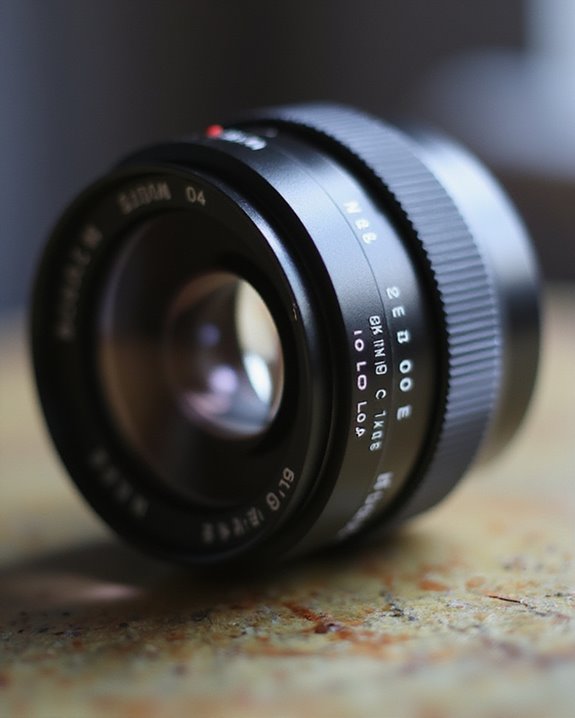In camera lenses, the “f” signifies the f-number, a precise ratio of focal length to aperture diameter, which governs light exposure and depth of field. For example, an f/2.8 setting, calculated as focal length divided by 2.8, widens the aperture for greater light intake compared to f/4, enhancing low-light performance while producing shallower focus. Standard values like f/1.4, f/2, and f/5.6 halve light per stop, affecting shutter speed and image sharpness. Further insights into applications expand understanding.
Key Takeaways
- In camera lenses, ‘f’ denotes the focal length, the distance from the lens to the sensor when focused at infinity.
- The f-number, like f/2.8, is the ratio of focal length to the aperture’s entrance pupil diameter, controlling light intake.
- A lower f-number widens the aperture, allowing more light for better exposure in low-light conditions.
- Lower f-stops create a shallower depth of field, isolating subjects by blurring backgrounds.
- Common f-stop values include f/1.4, f/2.8, f/4, f/5.6, and f/8, each halving light entry per full stop.
What Is F-Stop?
The f-stop, a key metric in photography, quantifies the ratio of a lens’s focal length to the diameter of its entrance pupil, thereby controlling the amount of light that reaches the camera sensor. Aperture, determined by this ratio, directly affects light intake; for instance, a larger aperture corresponds to a lower f-number, enhancing exposure in dim conditions. Using the formula N = focal length / entrance pupil diameter, an f/2.8 lens exemplifies this, where a 50mm focal length yields a 17.86mm pupil. The standard f-stop scale, including values like f/1.4, f/2, f/2.8, f/4, and f/5.6, halves light per stop, with maximum aperture values like f/1.4 maximizing light entry. Aperture value adjustments enable precise control, as lower f-numbers, such as f/2.8, facilitate brighter images compared to higher settings like f/8, optimizing for various photographic needs. Moreover, wide-aperture lenses such as those with f/1.4 aperture provide superior low-light performance by enabling faster shutter speeds and reduced image noise in challenging environments.
The Meaning of ‘f’ in Lenses
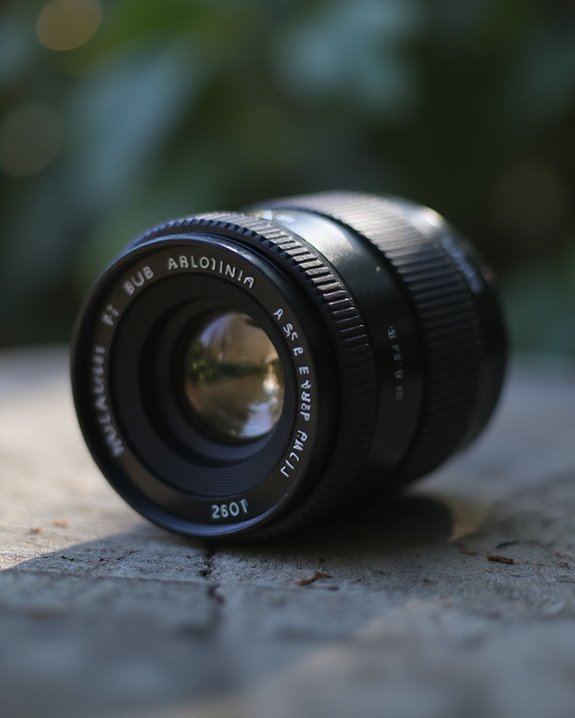
Focal length, as denoted by ‘f’ in camera lens specifications, serves as the foundational measure for the f-number, representing the distance from the lens to the image sensor when focused at infinity and forming the ratio of this length to the entrance pupil’s diameter. In camera lenses, F stands for focal, specifically the focal length, which defines the lens’s focal ratio—the division of focal length by aperture diameter. For example, a 50mm lens at maximum aperture of f/1.8 has an aperture diameter of approximately 27.78mm, calculated as 50mm divided by 1.8, enhancing light-gathering ability. Lenses with lower f-numbers, such as f/1.4, provide wider apertures than higher values like f/16, allowing greater light entry while maintaining precise control. This focal length metric guarantees technical accuracy in lens design, enabling photographers to select based on desired focal and aperture characteristics. Comparative analysis shows that wider maximum apertures correlate directly with improved light-gathering ability in various lenses. For instance, the f/1.4 aperture in lenses like the Canon EF 50mm f/1.4 USM allows for superior light collection in low-light environments, as it gathers four times more light than an f/2.8 aperture.
How F-Number Influences Exposure
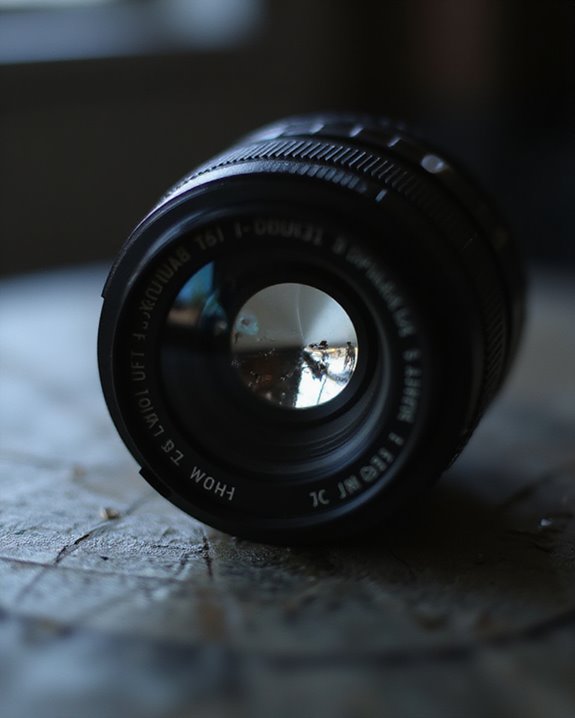
How the f-number modulates exposure directly correlates with aperture size, where a lower value, such as f/2, enlarges the opening to admit more light—up to four times that of f/4—since illuminance decreases with the square of the f-number, thereby increasing sensor brightness while necessitating adjustments for ideal results. The f-number determines aperture diameter, with a larger aperture admitting greater amounts of light for enhanced exposure in low-light scenarios, as seen in f/1.4 settings that enable faster shutter speeds. Conversely, a smaller aperture, like f/4, halves the amount of light from f/2.8, reducing light entering and requiring slower shutter speeds to achieve correct exposure. On the standard f-stop scale—f/1, f/1.4, f/2, f/2.8—each increment halves light intake, demanding reciprocal shutter speed or ISO adjustments. For instance, the sunny 16 rule pairs f/16 with 1/100 second at ISO 100, illustrating how higher f-numbers limit light for balanced exposure in bright conditions. Additionally, wider apertures with lower f-numbers not only enhance light intake but also produce a shallow depth of field to isolate subjects effectively in portrait photography.
F-Stop and Depth of Field Effects
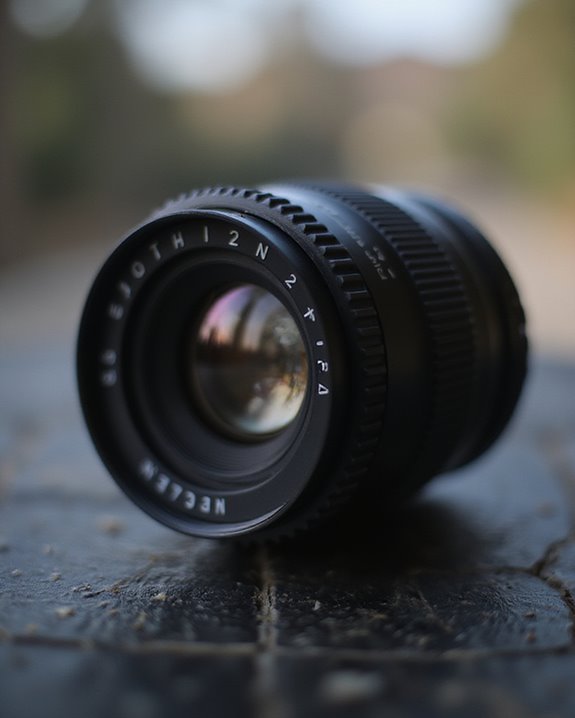
Beyond its role in modulating light exposure, f-stops exert a profound influence on depth of field, where a lower value like f/2.8 widens the aperture to produce a shallower focus range, isolating subjects by blurring foreground and background elements, as seen in portrait photography that prioritizes subject sharpness within a 1-meter plane at typical distances. Lowering the f-number, such as to f/2.8, opens a large aperture for enhanced depth of field effects, while a higher f-number like f/16 employs a small aperture to deepen focus, sharpening more scene elements. Aperture settings between f/5.6 and f/8 often optimize image sharpness by balancing larger maximum aperture benefits with smaller apertures that minimize diffraction. For instance, shifting from f/4 to f/11 extends the focused area, improving overall clarity in landscapes, though extreme settings like f/32 may compromise sharpness.
Common F-Stop Values in Photography
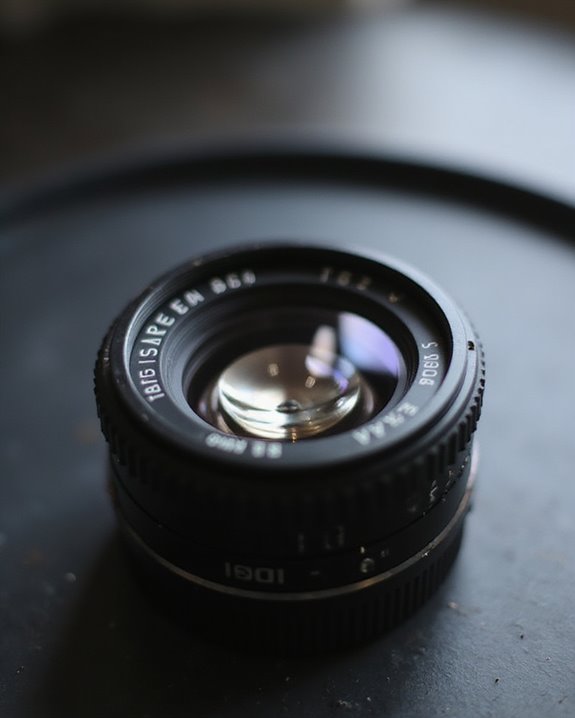
Common f-stop values in photography, such as the standard full-stop series of f/1.4, f/2, f/2.8, f/4, f/5.6, f/8, f/11, f/16, and f/22, systematically adjust light intake by halving or doubling the aperture size with each step, based on multiples of the square root of 2 for precise exposure control. Aperture, defined by the aperture scale, ranges from the largest aperture, like a maximum aperture of f/1.8 for low-light scenarios, to small apertures such as f/16, enhancing depth of field in landscapes. One stop changes, for instance from f/2.8 to f/4, halve the size of the aperture, affecting exposure and sharpness. The aperture range on modern lenses includes one-third stop increments, like f/3.2 to f/3.5, for finer adjustments. Aperture of f values, such as f/11, represent precise control over aperture size, ensuring ideal light and focus balance through comparative analysis of exposure settings.
Frequently Asked Questions
Is a 1.6 or 1.8 Aperture Better?
Like a vast horizon, Aperture Preference often favors a 1.6 over 1.8 for Speed Advantage and superior Light Sensitivity, enhancing Bokeh Comparison and Depth Variation. Sharpness Test, Exposure Impact, Performance Metrics, and Quality Debate guide ideal Lens Choice.
What Does F 2.8 Mean for a Camera Lens?
F/2.8, as a photography term, defines the focal ratio and aperture value, enhancing light intake and exposure control while creating depth effect and bokeh. It influences speed rating, lens quality, and overall imaging for creative applications.
Is a Higher F Value Better Camera?
Satirically, envision a camera lens as a stubborn gatekeeper: Higher F Values, amid Aperture Myths, enforce Depth Tradeoffs and Sharpness Benefits but impose Light Impact and Exposure Drawbacks, fueling Camera Myths, Quality Debates, and F Number Uses for varied Lens Effects.
Which Has a Larger Aperture, F 2.8 or F-16?
In Aperture Comparison, F Stop Basics reveal that f/2.8 has a larger Lens Opening than f/16, boosting Light Intake and altering Depth Effects, which impacts Shutter Impact, Exposure Basics, Focus Range, Bokeh Tips, and Creative Shooting.




